Int'l J. of Communications, Network and System Sciences
Vol.2 No.5(2009), Article ID:596,7 pages DOI:10.4236/ijcns.2009.25037
A Novel Blind Channel Estimation for a 2x2 MIMO System
1Student Member IEEE, School of ITEE, The University of Queensland, Brisbane, Australia
2Fellow IEEE, School of ITEE, The University of Queensland, Brisbane, Australia
Email: {xialiu, meb, fwang}@itee.uq.edu.au
Received May 18, 2009; revised June 20, 2009; accepted July 17, 2009
Keywords: MIMO, Channel estimation, semi-Blind channel estimation, phase ambiguity
ABSTRACT
A novel blind channel estimation method based on a simple coding scheme for a 2 by 2 multiple input multiple output (MIMO) system is described. The proposed algorithm is easy to implement in comparison with conventional blind estimation algorithms, as it is able to recover the channel matrix without performing singular value decomposition (SVD) or eigenvalue decomposition (EVD). The block coding scheme accompanying the proposed estimation approach requires only a block encoder at the transmitter without the need of using the decoder at the receiver. The proposed block coding scheme offers the full coding rate and reduces the noise power to half of its original value. It eliminates the phase ambiguity using only one additional pilot sequence.
1. Introduction
Multiple Input Multiple Output (MIMO) signal transmission schemes are attractive for high-speed data transmission in wireless communication systems because they offer an increased data throughput (capacity) without increasing operational bandwidth [1,2]. Also they are capable to enhance the quality of signal transmission through the use of transmitter or receiver diversity. These advantages are possible under the condition that the MIMO channel state information (CSI) is available at the receiver. Traditionally, CSI can be acquired by sending training sequences (also known as pilot signals) evenly spaced along a block of transmit symbols. The disadvantage of this approach is that the training sequences take up the precious bandwidth. In order to save the bandwidth and increase spectral efficiency, blind and semiblind channel estimation methods can be applied to obtain the CSI.
Several blind channel estimation methods have been described in [3,4]. These methods are based on the subspace algorithm [5], which utilizes the orthogonality between the channel matrix and the Sylvester matrixformed noise subspace. There are several drawbacks of subspace-based MIMO channel estimation methods. One is that they suffer from so-called multi-dimensional ambiguity. As a result, several pilot sequences are needed to eliminate this ambiguity. Two, in order to compensate for extra degrees of freedom in the noise subspace when the number of transmit antennas is smaller than the number of antennas at the receiver, the pre-coding is required [3,4]. Also, EVD is an inherent part of the algorithm, which leads to high implementation complexities.
In [6,7], a semi-blind channel estimation method employing orthogonal pilot maximum likelihood (OPML) estimator has been proposed. The method performs singular value decomposition (SVD) to the received signal correlation matrix to estimate the ‘whitening’ matrix of channel. By using the ‘whitening’ matrix, the OPML estimator shows a 1dB improvement of bit error rate (BER) compared to the conventional least squares (LS) training scheme if the same length of training sequence is used. However, it still requires a large number of training symbols to achieve the same performance as LS. Furthermore, SVD has to be applied twice to obtain the ‘whitening’ matrix and the rotation matrix. These operations lead to the increased computational complexity.
The work in [8] presents a new SVD-based blind channel estimation scheme which uses a simple block pre-coding structure. The advantage of this approach is that CSI can be recovered without ambiguity if the proper modulation is applied. Another advantage of this scheme is that no block decoder is needed at the receiver. These advantages are gained at the expense of the coding rate. The coding rate decreases as more transmitting antennas are used. In particular, for a 2x2 MIMO system the code rate is 1/2, which results in wasting of the precious spectrum.
In this paper, we propose a novel blind channel estimation algorithm, which is of much lesser complexity than those based on SVD or EVD. Its important feature is that it preserves the advantages of the coding scheme described in [8] without sacrificing the coding rate. The new scheme offers a full coding rate (coding rate is equal to 1) when the number of transmitting antennas is equal to the number of receiving antennas. In the case of a 2x2 MIMO system, this coding scheme reduces the noise power to the half of the original noise power. This scheme exhibits the phase ambiguity. However, it can be eliminated using only one extra pilot sequence.
The rest of the paper is organized as follows. In Section 2, a model of MIMO system employing a block coding scheme is introduced. A new blind channel estimation method is described in Section 3. The solution of eliminating the phase ambiguity is given in Section 4. Simulation results are presented in Section 5. Section 6 concludes the paper.
2. System Description & Coding Scheme
In this paper, a narrow band block fading channel is assumed. The number of transmitting and receiving antennas is denoted as Nt and Nr, respectively. Thus the channel H is the Nr x Nt dimension channel matrix with hij representing complex response between the i-th receiving antenna and the j-th transmitting antenna. In further considerations Nt is assumed to be equal to Nr.
The input symbols at transmitter can be represented by
 (1)
(1)
where X stands for independent identically distributed (i.i.d) Gaussian random signals with zero mean and the variance matrix given by , where E{} implies the expectation and σs2 is the power of one symbol.
, where E{} implies the expectation and σs2 is the power of one symbol.
The symbols are encoded using a block encoder structure before being transmitted. As a result, the i-th symbol block is an element of matrix group .
.
The data received at the other end of the communication channel is affected by the channel properties and an additive noise. Therefore the relationship between the transmitted encoded symbols and received data is given as:
 (2)
(2)
where Yi is the Nr x NrNt received signal matrix and Ni is the Nr x NrNt (i.i.d) Gaussian random noise matrix with zero mean.
The coded output of the transmitter can be written as:
 (3)
(3)
where
 ,
,
 , (4)
, (4)
 ,
,  and
and  and
and .
.  ,
, ,
,  represent the encoder structure.
represent the encoder structure.
Therefore, the transmitted coded signals are
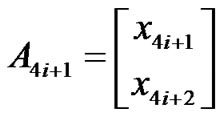 ,
,
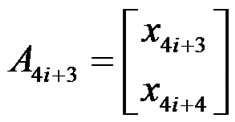 ,
,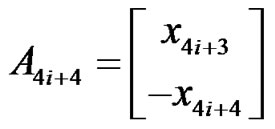 (5)
(5)
or
 (6)
(6)
From expression (6), one can observe that 4 symbols are sent in 4 symbol periods during one block. Therefore, the code rate is 1.
The received signal blocks can be written as (7):
 (7)
(7)
in which  is the random Gaussian noise matrix. An equivalent representation of (7) is given by (8):
is the random Gaussian noise matrix. An equivalent representation of (7) is given by (8):
 and
and
 and
and
By linking (8) directly to individual channel matrix elements, one obtains:
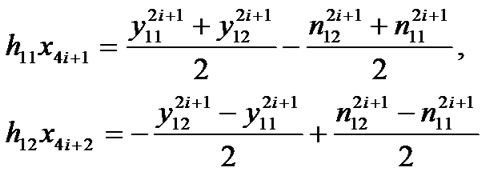 (9)
(9)
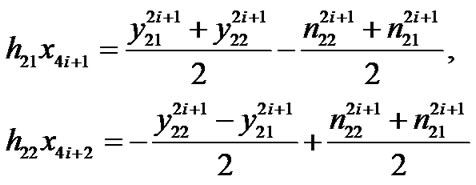 (10)
(10)
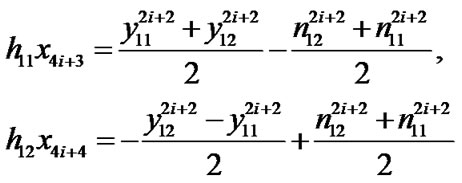 (11)
(11)
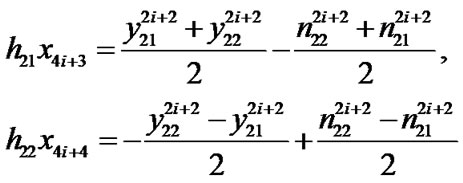 (12)
(12)
As a result, the relationship between the raw (transmitted) data and the received data is given by (13):
 (13)
(13)
in which the individual terms are identified by (14)
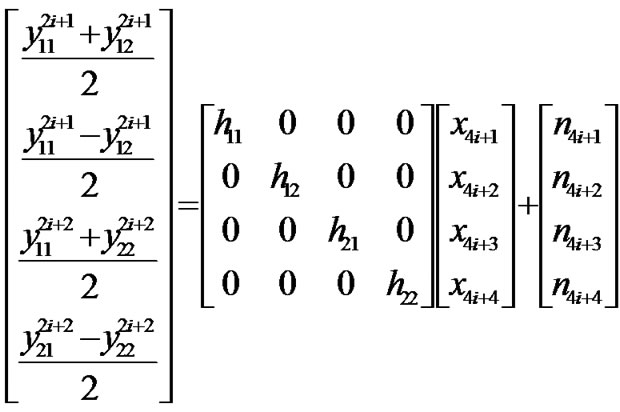 (14)
(14)
where
 (15)
(15)
Due to the fact that the elements in Ni represent a Gaussian random noise also the elements in obey the Gaussian distribution. However, the average power of each element in
obey the Gaussian distribution. However, the average power of each element in is half of that in Ni. In this case, the noise power is suppressed by the coding scheme.
is half of that in Ni. In this case, the noise power is suppressed by the coding scheme.
3. Blind Channel Estimation
The blind channel estimation requires the knowledge of the correlation matrix of![]() , which is given as:
, which is given as:
 (16)
(16)
Because the power of each element in  is half of that in the noise matrix Ni, then Equation (16) can be rewritten as:
is half of that in the noise matrix Ni, then Equation (16) can be rewritten as:
 (17)
(17)
If the information symbol sequence is of unit power then (17) becomes:
 (18)
(18)
where
 (19)
(19)
Thus (18) can be converted to (19)
 (20)
(20)
By introducing , the following holds:
, the following holds:
 (21)
(21)
where vec (.) means vector operation in which columns of H are stacked on top of each other and |.| denotes the absolute value.
 (22)
(22)
As a result
 (23)
(23)
The estimation of is equivalent to finding the roots of the diagonal elements in R.
is equivalent to finding the roots of the diagonal elements in R.
To obtain the solution, the square-root algorithm can be applied. One problem that is faced using this approach is that it introduces the phase ambiguity in the estimated . This is because the square roots are obtained for the norms of the elements of the channel matrix H. In the next section, a method for the phase ambiguity elimination is described.
. This is because the square roots are obtained for the norms of the elements of the channel matrix H. In the next section, a method for the phase ambiguity elimination is described.
4. Phase Ambiguity Elimination
It is apparent that the proposed blind channel estimation algorithm provides the information about the estimated norm of each element in channel matrix H of the 2x2 MIMO system as shown by the following.
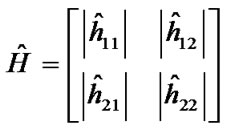 (24)
(24)
Now the task is to obtain the phases of these elements.
By sending one pilot sequence P where
 (25)
(25)
one obtains
 (26)
(26)
in which Yp and P are known. More specifically, we have
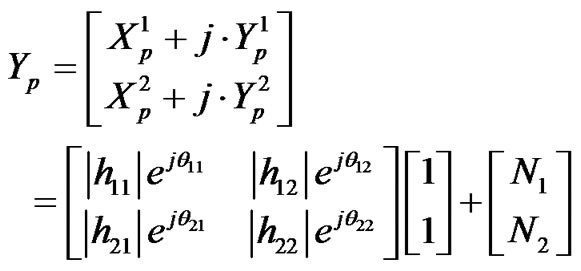 (27)
(27)
By replacing  in (25) by the estimated values, the following is obtained
in (25) by the estimated values, the following is obtained
 (28)
(28)
 (29)
(29)
 (30)
(30)
 (31)
(31)
To determine θ11, θ12, θ21 and θ22, Equations (9)(10) and (11)(12) are used in which (9)/(10) and (11)/(12) are formed. This operation results in the following
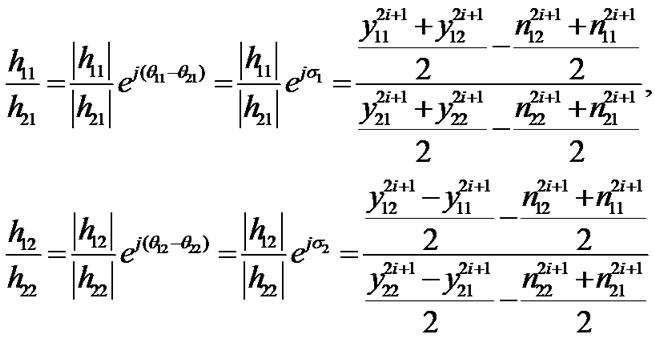 (32)
(32)
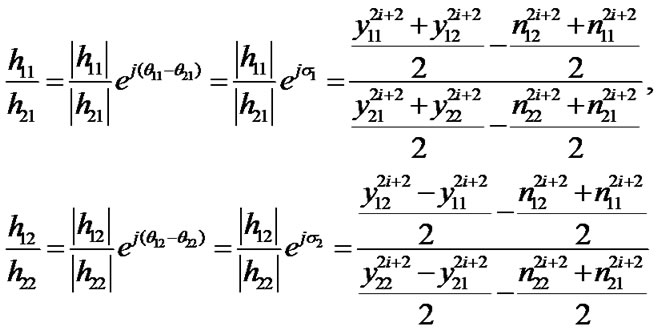 (33)
(33)
where σ1=θ11-θ21 and σ2=θ12-θ22.
Using Equations (32) and (33), σ1 and σ2 can be estimated by including noise impact. Then θ11, θ21 and θ12, θ22 can be expressed using the estimated σ1 and σ2 as,
 (34)
(34)
 (35)
(35)
By substituting (34) into Equations (32) and (35) into Equations (33), the phases θ11, θ21, θ12 and θ22 can be determined. Therefore, the phase ambiguity can be resolved.
5. Simulation Results
The validity of the proposed blind channel estimation algorithm for a 2x2 MIMO is investigated via computer simulations. For reference purposes, comparisons are made with a training-based channel estimation using the least square (LS) method and a semi-blind channel estimation using an orthogonal pilot maximum likelihood (OPML) algorithm. The following is the necessary information that is used to perform comparisons with the alternative channel estimation algorithms.
The performance of the proposed channel estimation is assessed in terms of mean square error (MSE) as given by
 (36)
(36)
in which ||.||F2 stands for the Frobenius norm.
In the LS method, the estimated channel matrix is given as [10],
 (37)
(37)
where {.}† stands for the pseudo-inverse operation.
The MSE of LS method is given as
 (38)
(38)
According to [11] and [12], the minimum value of MSE for the LS method is given as
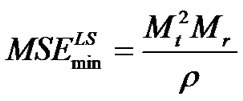 (39)
(39)
in which ρ stands for transmitted power to noise ratio in the training mode. Here we assume that the SNR in the proposed estimation scenario is equal to ρ.
In [6] and [7], a WR-based semi-blind channel estimation method was introduced. Following that method, the MIMO channel matrix H can be decomposed by applying the singular value (SV) decomposition
 (40)
(40)
where P and Q are two singular vectors corresponding to eigenvalues. Σ represents eigenvalues of H by the diagonal matrix. For both P and Q the following properties hold: PPH = PHP = I and QQH = QHQ = I. The whitening matrix W is given by W = PΣ and Q is the rotation matrix. The whitening matrix W can be obtained blindly by computing the second-order statistics of a received signal. Details are given in Section 2.3 of [13] and thus are not repeated here. The matrix W is assumed to be perfectly known at the receiver. Training sequences are used for estimating the unitary matrix Q. It has already been proved in [6] and [7] that such a unitary matrix Q helps increasing estimation gains because it uses a smaller number of parameters.
To estimate the rotation matrix Q, several algorithms can be applied. The orthogonal pilot maximum likelihood (OPML) algorithm offers the best performance, as demonstrated in [6]. In this algorithm, the training matrix Xp is set to have orthogonal properties with unit power and length equal to Nt, XpHXp = XpXpH = I. The OPML estimator is expressed as (36),
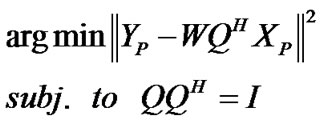 (41)
(41)
where Q is obtained by minimizing the likelihood.
Let , then by applying SVD to
, then by applying SVD to , we have
, we have
 (42)
(42)
It can be shown that the estimated  of Q that minimizes the likelihood is given as [6]:
of Q that minimizes the likelihood is given as [6]:
 (43)
(43)
The channel matrix H is then estimated as
 (44)
(44)
In Figure 1, the performance of LS method, OPML algorithm and the proposed blind estimation method for a 2x2 MIMO system are presented. The length of training sequences used by LS method and OPML algorithm is set to 2.
From Figure 1, one can see that when the number of received symbols increases, the blind estimation accuracy is improved. The performance of blind channel estimation is always better than offered by LS. This is mainly because the proposed algorithm reduces the noise power to half of the original one. When making comparison with OPML algorithm, one finds that the per-
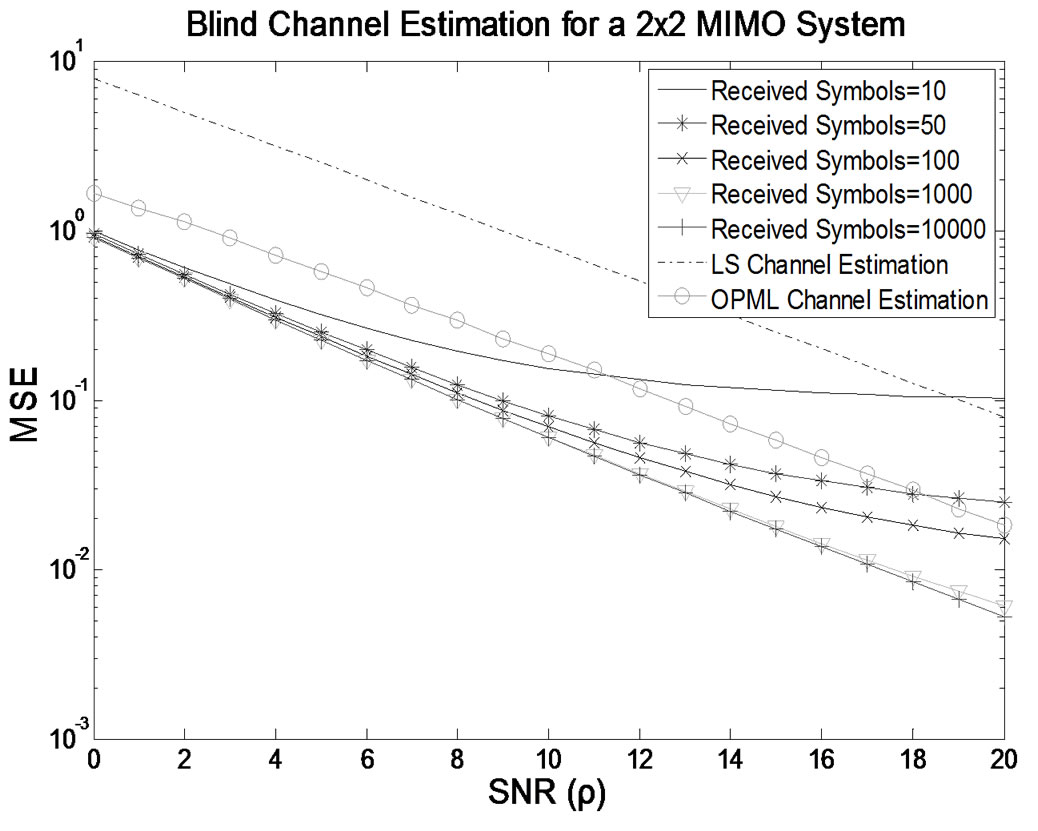
Figure 1. Performance of LS, OPML and newly proposed blind estimation algorithm for a 2x2 MIMO system for different values of SNR.

Figure 2. MSE as a function of number of received symbols for a newly proposed blind channel estimation method for a 2x2 MIMO system for different values of SNR.
formance of the proposed estimation algorithm is always better when the number of received symbols is equal or more than 100.
Figure 2 illustrates the convergence of the blind channel estimation for a 2x2 MIMO system. It can be seen that for each of the three assumed values of SNR, the convergence occurs within the first 100 received symbols. The use of a larger number of symbols (100 to 500) provides only a slight improvement. The full convergence occurs at about 700 symbols. One can see that with 100 received symbols the estimation is already very accurate irrespectively of the assumed value of SNR.
6. Conclusions
In this paper we have presented a novel blind algorithm for estimating a channel of a 2x2 MIMO. The proposed algorithm operates in conjunction with a suitable coding scheme and eliminates phase ambiguity for the estimated channel matrix coefficients. The coding scheme exhibits high spectral efficiency and reduces the noise power to the half of the original one that is present in a 2x2 MIMO system. The proposed algorithm involves the square-root operation which shows a low level of processing complexity. The simulation results prove a fast convergence rate for estimating the channel. The performance of the proposed algorithm is better than of the training-based Least Squares (LS) algorithm. Also it shows superiority over the Orthogonal Pilot Maximum Likelihood (OPML) semi-blind estimation algorithm when the number of received signal symbols exceeds 100.
7. References
[1] Telatar, “Capacity of multiple antenna Gaussian channels,” European Transactions on Telecommunications, Vol. 10, No. 6, pp. 585-595, November/December 1999.
[2] G. J. Foschini and M. J. Gans, “On limits of wireless communications in a fading environment when using multiple antennas,” Wireless Personal Communications, Vol. 6, pp. 311-335, 1998.
[3] S. Zhou, B. Muquet, and G. B. Giannakis, “Subspace-based (semi-) blind channel estimation for block precoded space-time OFDM,” IEEE Transactions on Signal Processing, Vol. 50, No. 5, pp. 1215-1228, May 2002.
[4] R. Zhang, “Blind OFDM channel estimation through linear Precoding: A subspace approach,” in Proceedings Asilomar’02, Pacific Grove, CA, November 2002.
[5] E. Moulines, P. Duhamel, J. F. Cardoso, and S. Mayrargue, “Subspace methods for the blind identification of multichannel FIR filters,” IEEE Transactions on Signal Processing, Vol. 43, pp. 516-525, February 1995.
[6] A. K. Jagannatham and B. D. Rao, “Whitening-rotationbased semi-blind MIMO channel estimation,” IEEE Transactions on Signal Processing, Vol. 54, No. 3, March 2006.
[7] A. Jagannatham and B. D. Rao, “Constrained ML algorithms for semi-blind MIMO channel estimation,” Proceedings of IEEE Communication Society Globecom, 2004.
[8] X. Liu and M. E. Bialkowski, “SVD-Based blind channel estimation for a MIMO OFDM system employing a simple block pre-coding scheme,” Proceedings of IEEE Eurocon, Poland, 2007.
[9] S. Shahbazpanahi, A. B. Gershman, and J. H. Manton, “Closed-form blind MIMO channel estimation for orthogonal space-time block codes,” IEEE Transactions on Signal Processing, Vol. 53, No. 12, December 2005.
[10] S. M. Kay, “Fundamentals of statistic signal processing: Estimation theory,” Prentice-Hall, Incorporation, 1993.
[11] M. Biguesh and A. B. Gershman, “MIMO channel estimation: Optimal training and tradeoffs between estimation techniques,” Proceedings ICC’04, Paris, France, June 2004.
[12] M. Biguesh and A. B. Gershman, “Training-based MIMO channel estimation: A study of estimator tradeoffs and optimal training signals,” IEEE Transactions on Signal Processing, Vol. 54, No. 3, March 2000.
[13] A. K. Jagannatham and B. D. Rao, “A semi-blind technique for MIMO channel matrix estimation,” Proceedings IEEE Workshop on SPAWC, Roma, Italy, 2003.

